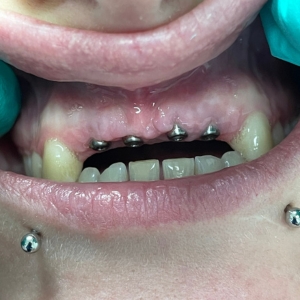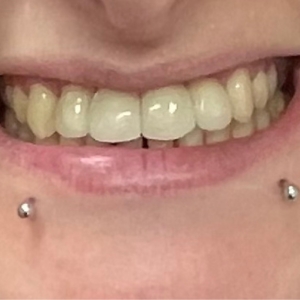Implants
An implant is a small titanium post that is surgically positioned into the jawbone to replace a missing tooth root.
What Are Implants?
A dental implant is an option to replace a missing tooth. In this procedure, a small titanium shaft is surgically implanted into the bone and allowed to set. The bone grows around it forming a tight connection, which additionally slows or stops the bone loss that occurs when the root of a natural tooth is missing. Once the implant is firmly set in the mouth, the dentist then works to attach the replacement tooth onto the top of the shaft. This permanent solution has the advantages over bridge work that it does not stress the surrounding teeth for support, and, should the tooth wear out, another can simply be replaced on the shaft.
How do we restore Implant?
A Dental Implant procedure is a multi-stage process that replaces tooth roots with metal, screw-like posts and replaces damaged or missing teeth with artificial teeth that look and function much like real ones. Here’s a breakdown of the steps involved:
Stage 1: Consultation and Planning
Consultation: You’ll consult with your dentist or oral surgeon to discuss your dental history, overall health, and treatment goals.
X-rays and CT scans: These imaging tests will help your dentist assess your jawbone density and the location of your nerves and blood vessels.
Treatment plan: Your dentist will develop a customized treatment plan based on your individual needs. This plan will outline the number and types of implants needed, the surgical procedure, and the estimated cost and timeline.
Stage 2: Surgery
Anesthesia: You will be given anesthesia to keep you comfortable during the surgery. This may be local anesthesia, IV sedation, or general anesthesia.
Implant placement: The surgeon will make an incision in your gum and prepare the jawbone for the implant. The implant is then surgically inserted into the jawbone.
Sutures: The incision will be closed with sutures.
Stage 3: Healing and Osseointegration
It will take several months for the implant to fuse with your jawbone in a process called osseointegration. During this time, you will wear a temporary restoration, such as a denture or flipper, to protect the implant site and maintain your appearance.

Stage 4: Abutment Placement
Once the implant has healed, your dentist will place a small connector piece called an abutment on top of the implant. The abutment will connect the implant to the artificial tooth.
Stage 5: Artificial Tooth Placement
Your dentist will create a custom-made artificial tooth, such as a crown, bridge, or denture, that fits over the abutment. The artificial tooth will be made to look and function like your natural teeth.
Restore your confidence, stability, and oral health with our Implants solutions.
Video courtesy to Lassus Tandartsen.
Smile Gallery
“What your future smile can look like“


Implant


Implant


Implant
Frequently Asked Questions
Is the implant procedure painful?
Discomfort is minimal and manageable, often similar to a tooth extraction.
How long does the implant process take?
It varies, but after the initial implant placement, a few months are needed for integration before attaching replacement teeth.
What are steps to keep in mind during recovery period?
Pain and swelling: You may experience some pain and swelling after surgery. This can be managed with over-the-counter pain medication.
Diet: You will need to eat a soft diet for the first few weeks after surgery.
Oral hygiene: It’s important to maintain good oral hygiene during the healing process. This includes brushing and flossing your teeth regularly and avoiding smoking and alcohol.
Overall, the dental implant procedure is a safe and effective way to replace missing teeth. With proper care, dental implants can last for many years.


